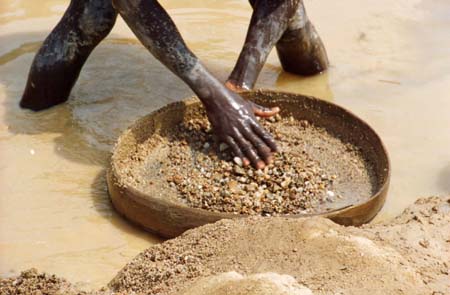Knowledge
30.05.2022 The Kimberley Process – stopping the trade of blood diamonds
Certificates of origin that prove where diamonds come from and that no conflicts or civil war parties have been financed by their sale – that is the goal of the Kimberley Process. How did it come about, what does the certificates prove, and how are the terms “blood diamond” and “conflict diamond” defined?

What are blood diamonds?
“Blood diamonds” have emblematic blood on them: they come from political trouble spots, often civil war countries in Africa, and their sale is used to finance the supply of the conflict parties. In the Kimberley Process, blood or conflict diamonds are defined as rough diamonds used by rebel movements to finance their military activities, especially attempts to overthrow legitimate governments.


All players in the diamond trade at the same table – the development of the Kimberley Process
In the 1990s, it became clear that the civil wars in Liberia and Sierra Leone were financed by the sale of blood diamonds. As a result, representatives of diamond producing countries as well as major importing countries and NGOs met in Kimberley, South Africa, in 2000, to develop a process for a clean and fair diamond trade. The so-called Kimberley Process has now been in effect since 2003. Only diamonds that have an official certificate of origin may be traded between all participants. In addition, participants may only trade with others who meet the same standards.
The participants in the Kimberley Process work in committees and meet twice a year. There are currently over 50 members worldwide, with the EU counted as one member. An up-to-date list of Kimberley Process participants can be found on the Kimberley Process website. Participants now represent 99.8% of the global diamond trade.

The certificate issued by the Kimberley Process
The rough diamonds are sealed in indestructible containers containing the Kimberley Process certificate. The certificate consists of a description of the contents of the shipment, the value, and dates of issue and expiration. In addition, the certificate has a unique number in accordance with the Regulation ISO 3166-1. An international body regularly checks whether states issue these certificates correctly and has import controls carried out.


Criticism of the Kimberley Process
In recent years, the Kimberley Process has been criticized by NGOs that were founding members – the organizations Global Witness and Impact subsequently withdrew from the process. The main criticism is that the trade in blood diamonds continues, partly because states issue fake certificates, for example for diamonds mined in other countries.
The Kimberley Process also lacks standards for the mining of diamonds, for example regarding human rights violations, child labor and forced labor. For this reason, in recent years several members have started efforts to expand the definition of blood diamonds in the Kimberley Process to include social and also ecological aspects in order to achieve even fairer trade and sale conditions for diamonds.

